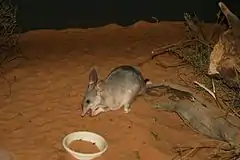| Thylacomyidae | |||
| Bensley, 1903[1] | |||
 Przedstawiciel rodzaju – wielkouch króliczy (Macrotis lagotis) | |||
| Systematyka | |||
| Domena | |||
|---|---|---|---|
| Królestwo | |||
| Typ | |||
| Podtyp | |||
| Gromada | |||
| Podgromada | |||
| Infragromada | |||
| Nadrząd | |||
| Rząd | |||
| Rodzina |
wielkouchowate | ||
| Typ nomenklatoryczny | |||
|
Thylacomys Blyth, 1840 (= Macrotis Reid, 1837) | |||
| Synonimy | |||
|
| |||
| Rodzaje | |||
| |||
Wielkouchowate[4] (Thylacomyidae) – rodzina torbaczy z rzędu jamrajokształtnych (Peramelemorphia). Podstawową cechą wyróżniającą są dłuższe niż u jamrajowatych uszy i ogon. Rodzina obejmuje największych przedstawicieli torbaczy jamrajokształtnych[5]. Wielkouchy kopią liczne nory na swoim terytorium. Należą do ssaków o najkrótszej ciąży, 12-14 dni, co stawia je tuż za jamrajowatymi.
Zasięg występowania
Rodzina obejmuje jeden występujący współcześnie gatunek zamieszkujący Australię[5][6].
Systematyka
Do rodziny należy jeden współcześnie występujący rodzaj[7][8][4]:
- Macrotis Reid, 1837 – wielkouch
Opisano również rodzaje wymarłe:
Uwagi
- ↑ Typ nomenklatoryczny: Macrotis Reid, 1837.
Przypisy
- ↑ A. Bensley. On the Evolution of the Australian Marsupialia; with Bemarks on the Relationships of the Marsupials in general. „Transactions of the Linnean Society of London”. Second Series. Zoology. 9, s. 110, 1903. (ang.).
- ↑ M. Archer & J.A.W. Kirsch. The case for the Thylacomyidae and Myrmecobiidae Gill, 1872, or why are marsupial families so extended?. „Proceedings of the Linnean Society of New South Wales”. 102, s. 21, 1977. (ang.).
- ↑ I.A.W. McAllan & M.D. Bruce. Some problems in vertebrate nomenclature. I. Mammals. „Bollettino del Museo Regionale di Scienze Naturali di Torino”. 7 (2), s. 454, 1989. (ang.).
- 1 2 Nazwy polskie za: W. Cichocki, A. Ważna, J. Cichocki, E. Rajska-Jurgiel, A. Jasiński & W. Bogdanowicz: Polskie nazewnictwo ssaków świata. Warszawa: Muzeum i Instytut Zoologii PAN, 2015, s. 9. ISBN 978-83-88147-15-9. (pol. • ang.).
- 1 2 R. Southgate: Family Thylacomyidae (Greater Bilby). W: D.E. Wilson & R.A. Mittermeier (redaktorzy): Handbook of the Mammals of the World. Cz. 5: Monotremes and Marsupials. Barcelona: Lynx Edicions, 2015, s. 350. ISBN 978-84-96553-99-6. (ang.).
- ↑ D.E. Wilson & D.M. Reeder (redaktorzy): Family Thylacomyidae. [w:] Mammal Species of the World. A Taxonomic and Geographic Reference (Wyd. 3) [on-line]. Johns Hopkins University Press, 2005. [dostęp 2020-10-24].
- ↑ N. Upham, C. Burgin, J. Widness, M. Becker, C. Parker, S. Liphardt, I. Rochon & D. Huckaby: Treeview of Mammalian Taxonomy Hierarchy. [w:] ASM Mammal Diversity Database (Version 1.11) [on-line]. American Society of Mammalogists. [dostęp 2023-07-27]. (ang.).
- ↑ C.J. Burgin, D.E. Wilson, R.A. Mittermeier, A.B. Rylands, T.E. Lacher & W. Sechrest: Illustrated Checklist of the Mammals of the World. Cz. 1: Monotremata to Rodentia. Barcelona: Lynx Edicions, 2020, s. 60–70. ISBN 978-84-16728-34-3. (ang.).
- ↑ R.A. Stirton. Late tertiary marsupials from South Australia. „Records of the South Australian Museum”. 11, s. 249, 1955. (ang.).
- ↑ K. Travouillon, S.J. Hand, M. Archer & K.H. Black. Earliest modern bandicoot and bilby (Marsupialia, Peramelidae and Thylacomyidae) from the Miocene of the Riversleigh World Heritage Area, northwestern Queensland, Australia. „Journal of Vertebrate Paleontology”. 34 (2), s. 378, 2014. DOI: 10.1080/02724634.2013.799071. (ang.).
Identyfikatory zewnętrzne:
This article is issued from Wikipedia. The text is licensed under Creative Commons - Attribution - Sharealike. Additional terms may apply for the media files.